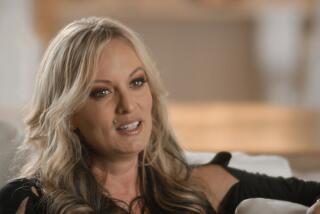Expressing Regret and Pain, Lewinsky Ends Her Silence
- Share via
NEW YORK — On the day after Bill Clinton’s 1996 reelection, Monica S. Lewinsky put on the black beret she knew he liked and joined a crowd of well-wishers on the South Lawn of the White House to give him a triumphant welcome home. For most Americans, it was the first image they have of her, a bubbly moon-eyed supporter giving Clinton a hug in the by-now familiar TV film clip.
But to Lewinsky, who expected to hear from Clinton in the days thereafter, it was a dark memory of the time when he began to break off their affair. He didn’t call, she said, “and I was throwing things, I was crying uncontrollably. I felt so betrayed and so disappointed. I was crushed.”
For the former White House intern, it was the onset of two years of intense emotional turmoil, which she unabashedly shared Wednesday with the nation. After 14 months of personal silence, interrupted only by grand jury testimony and other official interviews, Lewinsky finally got a chance to tell her own story. And the picture that emerged was of an insecure, sensitive and at times self-pitying young woman bullied by heartless men.
In the just-published book “Monica’s Story” and an ABC-TV interview watched by perhaps 40 million Americans, Lewinsky acknowledged her share of responsibility for the sexual affair that nearly destroyed Bill Clinton’s presidency. But most of the talk was about the pain and suffering she has gone through during the yearlong scandal that bore her name.
“I am probably the most humiliated woman in the world,” she says in the book written by Andrew Morton. “Yet I just can’t deal with that. . . . Certainly I made mistakes and foolish judgments, but did they warrant this level of abuse?”
In her book and the interview with Barbara Walters on “20/20,” Lewinsky, 25, talks of crying jags, thoughts of suicide and moments of black despair as her affair with the president ended and was later exposed. Under the harsh glare of the media, she wilted and came dangerously close to collapse.
Not surprisingly, she voices hatred for Linda Tripp, the woman who surreptitiously taped her conversations and turned them over to independent counsel Kenneth W. Starr; she recalls the terror of being detained by Starr’s investigators in a hotel room and threatened with 27 years in prison; and her mother criticizes Lewinsky’s former Los Angeles-based attorney, William Ginsburg, as being more concerned with publicity than Lewinsky’s best interests. As for her view of Clinton, Lewinsky is emotionally torn, telling Walters: “Sometimes, I have warm feelings, sometimes I’m proud of him still, and sometimes I hate his guts. And, um, he makes me sick.”
At times, she sounds almost infantile, at other times, worldly wise. Amid the torrent of emotion, it often requires an outside voice, like her mother, to stress that Lewinsky is accountable for her own actions: “No matter how much we love Monica, no matter how we defend her,” Marcia Lewis told Morton, “we do recognize that she bore responsibility for what happened.”
The torrent of televised and hard-cover emotions was in marked contrast to the self-possessed young woman who sparred lightly with House prosecutors in a taped deposition played before the U.S. Senate only last month. Still, her story remained the same.
In the book, published by St. Martin’s Press, Lewinsky shares her innermost thoughts with Morton, a best-selling writer who previously wrote a biography of Princess Diana. But the reader searches in vain for an extended glimpse into Lewinsky’s soul. “Monica’s Story” is written in the third person, with a surprisingly small number of direct quotes from Lewinsky herself. And the statements she makes sound like they came from a romance novel, heavy on grief, despair and passion.
There are some memorable moments, to be sure. When Lewinsky learns in April 1996 that she has been transferred to a job in the Pentagon, the intern is heartbroken: “I was hysterical all weekend. All I did was cry and eat pizzas and sweets.”
Describing her initial sexual encounters with Clinton, she notes: “People have made it seem so demeaning for me, but it wasn’t. It was exciting and the irony is that I had the first orgasm of the relationship.”
As for the stained dress that became key evidence, Lewinsky insists she kept it, not as a trophy or evidence, but rather because it no longer fit, though she hoped it would again. She says the dress was a joke among her friends.
Hardly shy, Lewinsky was blunt with the president about his family, telling him: “I don’t doubt that you have a deep bond [with First Lady Hillary Rodham Clinton], but to me, I think she has cold eyes. You seem to need so much nurturing, and the only person you seem to have worth for is your daughter.”
The book ends on a plaintive note, with Lewinsky swaying on a swing in the Holmby Hills park she played in as a child. She is, Morton writes, “a child-woman searching for a future and trying to obliterate a past. . . . And so it will remain, until one day the media circus moves on.”
But Lewinsky clearly needs the media circus to tell her story, and the much-ballyhooed interview with Walters was a key part of her plan to cash in financially on her moment in the sun. After a year of waiting to hear and see Lewinsky in an interview that cost advertisers $800,000 a minute, however, the public didn’t hear a lot of new information.
She was thrilled by the affair, she told the veteran host of “20/20.” She was hurt by the affair. She was mistreated by prosecutors. She was, ultimately, misunderstood.
What was new were the multiple close-ups of Lewinsky’s artfully made-up face with rivers of lip gloss and eyeliner that the audience could study while she talked about how Clinton hugged her and Starr’s prosecutors frightened her. Alternately humorous and somber, playful and straightforward, she seemed to make a serious effort to tell the truth about what happened and to get on with her life.
There were 24 occasions in the two-hour show when Lewinsky giggled or laughed, at least a dozen deep sighs and, of course, the de rigueur Walters moment when Lewinsky broke down while talking about the toll the scandal had on her family and how her parents have considered suicide.
“Behind the name Monica Lewinsky there’s a person and there is a family,” she told Walters. “And there has been . . . so much pain that has been caused by all this.”
She offered an apology at the start of the interview for the pain she has caused Hillary and Chelsea Clinton. But the apology may have struck some as hollow, as Lewinsky told a national television audience what a great kisser the president is and how he had contemplated leaving the first lady after his presidency was over.
At one point, Walters pointedly asked: “Where was your self-respect? Where was your self-esteem?” She called Lewinsky a “big mouth” for telling 11 people about her relationship with the president. Walters also emphasized the generational difference between them, asking Lewinsky to define “oral sex” and reacting as if she, Walters, had never heard of such a thing before that moment.
When Lewinsky referred to “the meanies” in the White House who thought she should be kept away from the president, Walters challenged her again: “Well, you call them the ‘meanies,’ but in a way, they were right, weren’t they?”
Lewinsky, flashing her own view of sex, shot back: “I don’t think so. I don’t think . . . I don’t think that my relationship hurt the job he was doing. It didn’t hurt the work I was doing. It was between us.”
At the end, Walters asked Lewinsky: “What will you tell your children, when you have them?” And America’s most famous intern answered: “Mommy made a big mistake.”
Getlin reported from New York, Baum from Washington. Times staff writer Judy Pasternak and researcher Lisa Meyer contributed to this story.
Take an informal survey about the Monica S. Lewinsky interview on The Times’ Web site at:
https://www.latimes.com/lewinsky
More to Read
Sign up for Essential California
The most important California stories and recommendations in your inbox every morning.
You may occasionally receive promotional content from the Los Angeles Times.












